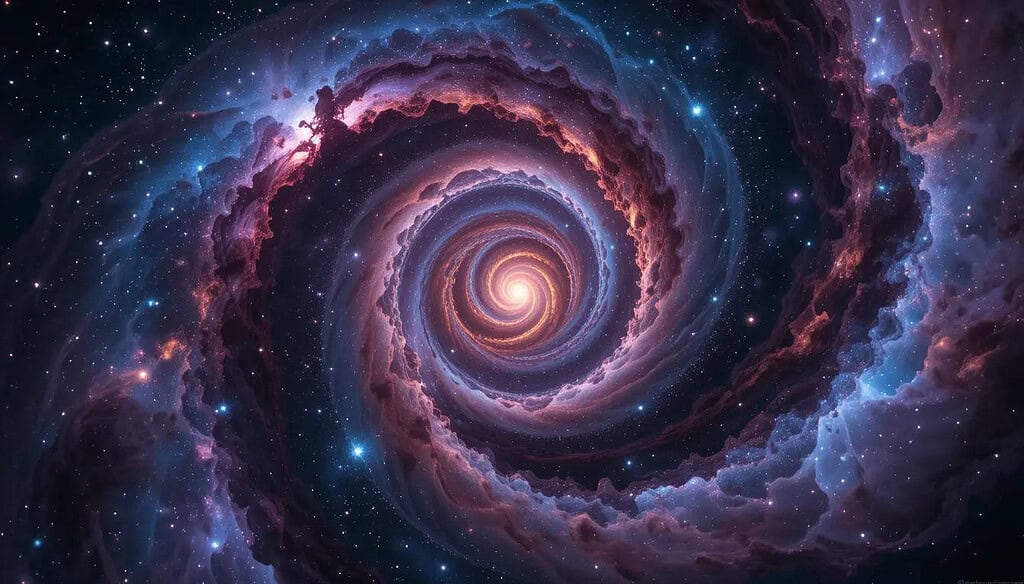Table of Contents
Welcome to the Galaxy’s Gossip Column
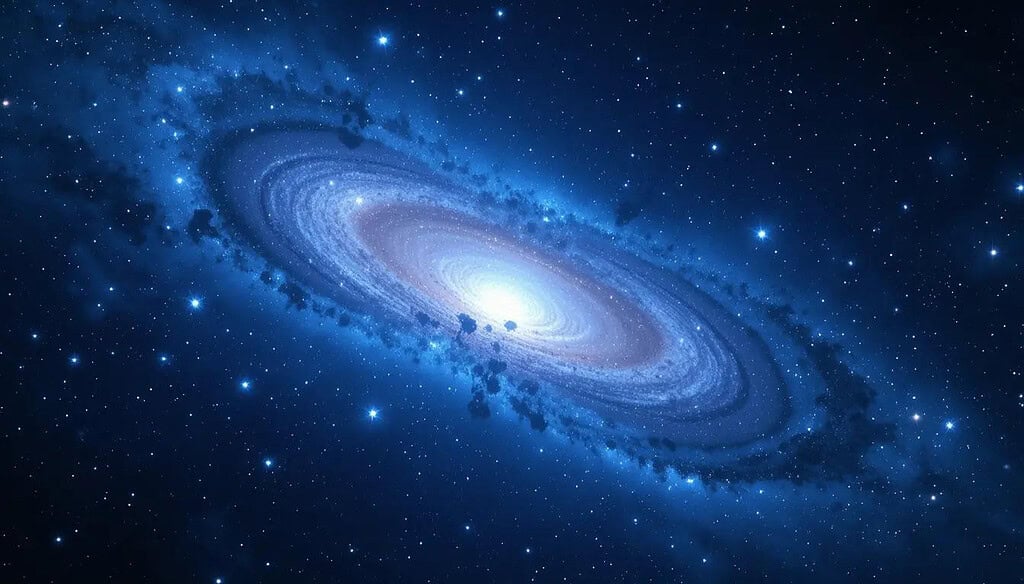
Welcome to the cosmic grapevine, where galaxies spill their secrets and the universe is one giant stage for drama! If you’ve ever looked up at the night sky and thought, “Wow, it’s so peaceful,” think again. The universe is anything but calm—it’s a cosmic soap opera where galaxies clash, merge, and occasionally devour each other. And you thought human scandals were juicy?
Let’s begin with the galaxy fundamentals. A galaxy is essentially a vast assembly of stars, gas, dust, and dark matter, all bound together by gravity. It may seem straightforward, but it’s anything but. A galaxy resembles any typical family—appearing lovely at first glance, yet filled with intricate dynamics and concealed mysteries. Galaxies are always competing for attention, engaging in dramatic events like collisions, stealing stars, or creating stunning formations. And here’s the kicker: our very own galaxy – Milky Way – is right in the thick of it.
Our galaxy Milky Way, while impressive, has its own share of hidden truths. It’s on a path to collide with our closest galaxy Andromeda. This isn’t a friendly encounter. In a few billion years, these two will clash in a spectacular display of gravitational forces, ultimately merging into a colossal galaxy. But that’s just scratching the surface. Our galaxy Milky Way has been quietly consuming smaller galaxies for ages, much like a cosmic predator.
This article isn’t about the boring technicalities of galaxies. Oh no, we’re here for the juicy details—the scandals, the drama, and the unexpected twists that make galaxies the most fascinating divas of the universe. From dark matter secrets to starburst parties, galaxies are teeming with stories that rival anything you’ve seen on reality TV.
So, buckle up for a tour through the universe’s hottest gossip. We’re about to uncover eight jaw-dropping galactic scandals that will make you see the cosmos in a whole new light. Who knew space could be this entertaining?
The Galaxy’s Top 8 Juicy Scandals
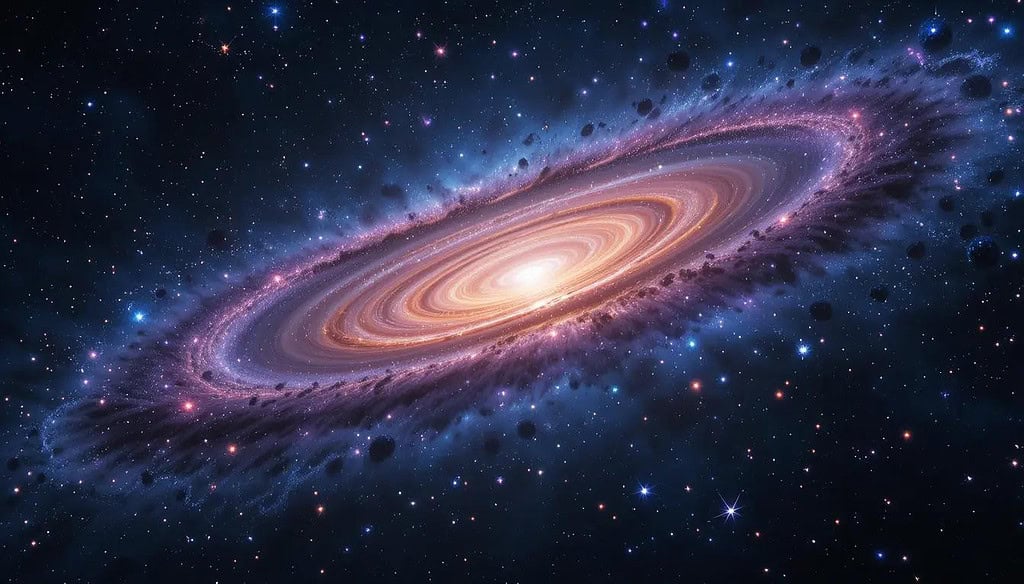
1. Infatuated Andromeda’s Bold Move: Heading Straight for the Milky Way!
If you think drama in the galaxy is limited to soap operas, think again. Andromeda (Messier 31), the closest large galaxy to our Milky Way, is making a bold move as it is infatuated with our galaxy Milky Way. Andromeda is gearing up for a cosmic collision of epic proportions. This is no ordinary encounter; it’s a head-on crash that will completely reshape both galaxies. But don’t panic just yet. This dramatic event is set to take place in about 4.5 billion years, so we’ve got plenty of time to sit back and enjoy the ride.
When Andromeda and the Milky Way finally collide, it’s not like two cars slamming into each other. Galaxies are made mostly of empty space, so most stars won’t crash into each other. However, the gas and dust in both galaxies will interact in incredible ways, triggering the birth of thousands of new stars. Think of it as a cosmic fireworks display. Over time, the two galaxies will merge, creating a completely new galaxy, likely an elliptical one, known as “Milkomeda.”
What makes this collision particularly intriguing is the impact it will have on our solar system. While it’s difficult to predict exactly what will happen, it’s likely that our solar system will be tossed into a completely new part of the galaxy, altering our view of the universe. As the two galaxies spiral into each other, the gravitational forces will drag the stars, dust, and gas together, creating something entirely new. And in the end, what we’ll have is a new galaxy, born from the fiery collision of two behemoths. It’s the ultimate cosmic makeover, and we’ll get to watch (in theory) from our distant corner of the universe.
2. The Milky Way’s Secret Affair with Dark Matter
The Milky Way’s relationship with dark matter is one of the most fascinating and mysterious cosmic affairs. For decades, astronomers have been trying to figure out exactly what dark matter is. And although it’s invisible, it holds a secret that no one can deny: dark matter is responsible for holding our galaxy and all other galaxies together.
You’ve probably heard about dark matter, but you may not know how crucial it is to the Milky Way. Scientists discovered dark matter when they realized that all the galaxies were spinning too quickly for the amount of visible matter it contained. Stars, gas, and dust alone couldn’t account for the galaxies’ rapid rotation. Something invisible, something with mass, had to be out there. Enter dark matter, a mysterious substance that doesn’t interact with light or normal matter but has enough gravitational influence to hold the galaxies intact.
Now, let’s keep this affair under wraps. We can’t see dark matter, and it doesn’t reveal its true identity. We only know it’s there because of its gravitational pull. Our galaxy Milky Way’s secret lover, dark matter, forms an invisible halo around the galaxy, giving it its structural integrity. Without dark matter, the Milky Way would have disintegrated long ago, as the stars would have flown off into space. So, while the galaxy may not be willing to admit it, dark matter is its unsung hero, quietly keeping the galaxy in place while staying in the shadows. And who knows? Maybe dark matter has a few more secrets to reveal as we continue our cosmic investigation.
3. Starburst Galaxies: Party Animals of the Cosmos
If galaxies were invited to a cosmic party, starburst galaxies would be the life of the event. These galaxies are notorious for their extravagant star formation, producing new stars at a rate hundreds of times faster than ordinary galaxies. It’s like a cosmic rave where the stars just keep pouring in—one after another—creating a spectacular light show that would rival any fireworks display.
So, why are starburst galaxies so wild? The answer lies in the chaotic collisions between galaxies or the interaction of a galaxy with a nearby gas-rich galaxy. These events compress the gas within the galaxy, causing it to collapse and trigger an intense burst of star formation. In galaxies like the Antennae Galaxies, the collision between two galaxies creates an energetic star-forming frenzy. The result is an explosion of bright, young stars scattered throughout the galaxy, which in turn creates an awe-inspiring sight in the cosmos.
However, as with every party, there’s a time when the music has to stop. Starburst galaxies can’t maintain their high rate of star formation forever. Once the available gas and dust are depleted, the star-making process slows, and the starburst galaxies settle into a calmer state. Even so, during their prime, starburst galaxies are the undisputed party animals of the galaxy world. They shine brightly for billions of years, leaving behind a legacy of beautiful new stars.
4. Galactic Cannibals: Who Ate Whom?
In the galaxy world, it’s not all peace and love. Some galaxies are outright cannibals, devouring their smaller neighbors and growing even more massive in the process. The phenomenon known as galactic cannibalism occurs when a larger galaxy pulls in a smaller galaxy and absorbs it. And the Milky Way? Well, it’s been known to gobble up a few smaller galaxies itself. In fact, our galaxy has been feasting on smaller galaxies for billions of years.
One of the most famous cases of galactic cannibalism is the Sagittarius Dwarf Galaxy, which was slowly torn apart by the Milky Way’s gravitational forces. The Milky Way has a voracious appetite when it comes to consuming smaller galaxies. It doesn’t stop there, though. Larger galaxies in the universe are constantly consuming smaller ones to grow bigger and more powerful.
But here’s the twist—galactic cannibalism isn’t always a one-time deal. The process is ongoing and involves the absorption of stars, gas, and dark matter. When a smaller galaxy is consumed, its mass is added to the larger galaxy, and its star formation can continue in a new, more powerful form. For the Milky Way, this process will continue for billions of years, slowly absorbing any smaller galaxies that wander too close. It’s survival of the fittest in the galaxy world, and the larger galaxies are always the ones coming out on top.
5. Ring Galaxies: Cosmic Fashionistas with Stunning Shapes
When it comes to aesthetics, ring galaxies are like the supermodels of the cosmos. These galaxies, with their unique ring-like structure, are both rare and stunning. If galaxies had fashion designers, ring galaxies would be strutting down the runway in a beautifully crafted cosmic gown. One of the best-known examples of a ring galaxy is Hoag’s Object, which is an almost perfect example of this rare phenomenon.
So, how do ring galaxies form? They are the result of a cosmic collision, often when a smaller galaxy passes through the center of a larger one. The gravitational forces caused by the interaction distort the galaxy, creating a ring of stars and gas around the center. The end result is a visually striking galaxy that looks like a glowing halo in space.
Despite their beauty, ring galaxies don’t last forever. Over time, the intense energy from the collision dissipates, and the galaxy’s ring structure begins to fade. But even as their shape becomes less defined, ring galaxies remain one of the most fascinating and visually captivating objects in the universe. With their perfectly symmetrical structure and ethereal glow, ring galaxies are the fashion icons of the galaxy world, always leaving a lasting impression on those lucky enough to see them.
6. Galactic Mergers: The Universe’s Messiest Breakups
Galactic mergers are like the messy breakups of the cosmos. When two galaxies collide, chaos ensues. Stars are thrown around, gas and dust are scattered, and the entire structure of both galaxies is completely reorganized. It’s a long, drawn-out process that takes billions of years, but the end result is often a much larger and more massive galaxy.
Take the collision between the Milky Way and Andromeda, for example. When these two galaxies merge in the distant future, it’s going to be a messy and dramatic event. The gravitational forces will tear apart both galaxies, creating new stars, new black holes, and an entirely new galaxy in the process. This is the universe’s version of a breakup, with both galaxies going through a painful but necessary transformation.
While galactic mergers might seem chaotic, they play a critical role in the evolution of galaxies. They contribute to the formation of new stars, new star systems, and even supermassive black holes. It’s a messy, turbulent process, but without it, galaxies wouldn’t evolve and grow in the way they do. Galactic mergers are a cosmic reminder that sometimes, chaos leads to beauty and new beginnings.
7. Peculiar Galaxies: Rebels Without a Cause
Not all galaxies fit neatly into the cosmic norm. Some galaxies are just plain peculiar, with strange shapes, bizarre behaviors, and a complete disregard for the established rules of galaxy formation. These “rebel” galaxies often arise from chaotic processes, like galactic collisions or interactions with other galaxies, which cause them to break away from the traditional spiral or elliptical shapes we typically see.
One such peculiar galaxy is the Cartwheel Galaxy. This galaxy, which looks like a giant wheel in space, formed after a smaller galaxy passed through the center of a larger one, distorting its shape and creating a ring of stars. Peculiar galaxies are often irregular in shape, and they challenge our understanding of how galaxies form. Their unique characteristics make them stand out in the vast expanse of the universe, and they offer a glimpse into the chaotic processes that shape the cosmos.
These peculiar galaxies are the rebels of the galaxy world. They don’t conform to the typical expectations, and that’s what makes them so fascinating. They’re a testament to the unpredictable nature of the universe, where anything can happen, and the rules are constantly being rewritten.
8. Supermassive Black Holes: The Galaxy’s Powerful CEOs
In the center of almost every galaxy, you’ll find a supermassive black hole. These enormous, gravity-defying entities act as the ultimate leaders in the galaxy, playing a crucial role in determining its structure and dynamics. With masses that can be millions to billions of times greater than that of the Sun, supermassive black holes serve as the gravitational “CEOs” of their galaxies, influencing the fate of everything in their vicinity.
The influence of supermassive black holes is undeniable. They control the galaxy’s core, devouring any stars, gas, or dust that gets too close. In doing so, they power some of the most energetic and dramatic phenomena in the universe, such as quasars and active galactic nuclei. These powerful black holes are essential to the function and stability of their galaxies, and without them, galaxies would lack the gravitational anchor that keeps everything in place.
One of the most famous supermassive black holes is located at the center of the Milky Way, known as Sagittarius A*. This black hole weighs about 4 million times as much as our Sun, and it exerts a powerful gravitational pull that shapes the entire galaxy. Supermassive black holes are more than just cosmic oddities—they’re the ultimate managers of the galaxy, ensuring that everything runs smoothly and efficiently.
When Galaxies Collide: The Drama Gets Real
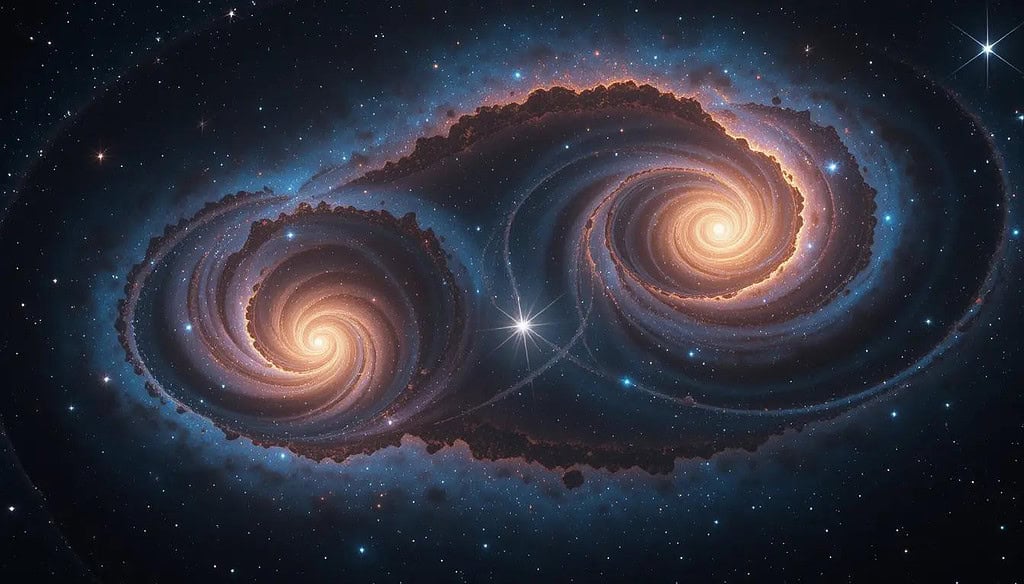
Galaxies colliding? Sounds like a disaster, right? Actually, it’s one of the most spectacular events in the universe. Picture two elegant dancers on a grand stage, swirling closer and closer until their movements become one dramatic, chaotic performance. That’s what happens when galaxies collide—a cosmic ballet where stars, gas, and dust take center stage.
But let’s get one thing straight: these collisions are anything but polite. Galaxies don’t just brush past each other with a nod and a smile. Oh no, they crash, stretch, twist, and sometimes completely consume each other. It’s cosmic chaos at its finest. Imagine a traffic jam in space, with billions of stars caught in a gravitational tug-of-war. Yet, surprisingly, individual stars rarely collide—there’s just too much empty space between them.
One of the most exciting outcomes of these galactic mashups is the birth of new stars. When gas clouds from two colliding galaxies meet, they compress and ignite in bursts of star formation. It’s like the universe’s way of saying, “Let’s make something beautiful out of this mess.” And the result? Stunning sights like starburst galaxies, where stars are born at an astonishing rate.
And then there are the black holes—those enigmatic powerhouses lurking at the center of most galaxies. When two galaxies collide, their black holes don’t just sit idly by. They spiral toward each other in a slow, dramatic dance that can last millions of years, eventually merging into an even more massive black hole. It’s the ultimate cosmic showdown.
Collisions aren’t just destructive; they’re transformative. They can completely change a galaxy’s shape, turning a calm spiral into a chaotic irregular galaxy or merging two smaller galaxies into a massive elliptical one. These events reshape the universe, creating some of the most breathtaking phenomena ever observed.
So, while galactic collisions might sound like a nightmare, they’re actually a crucial part of the cosmic cycle. It’s destruction and creation rolled into one—a reminder that even in chaos, there’s beauty. And honestly, isn’t that what makes the universe so captivating?
Wrapping Up the Galaxy’s Greatest Gossip
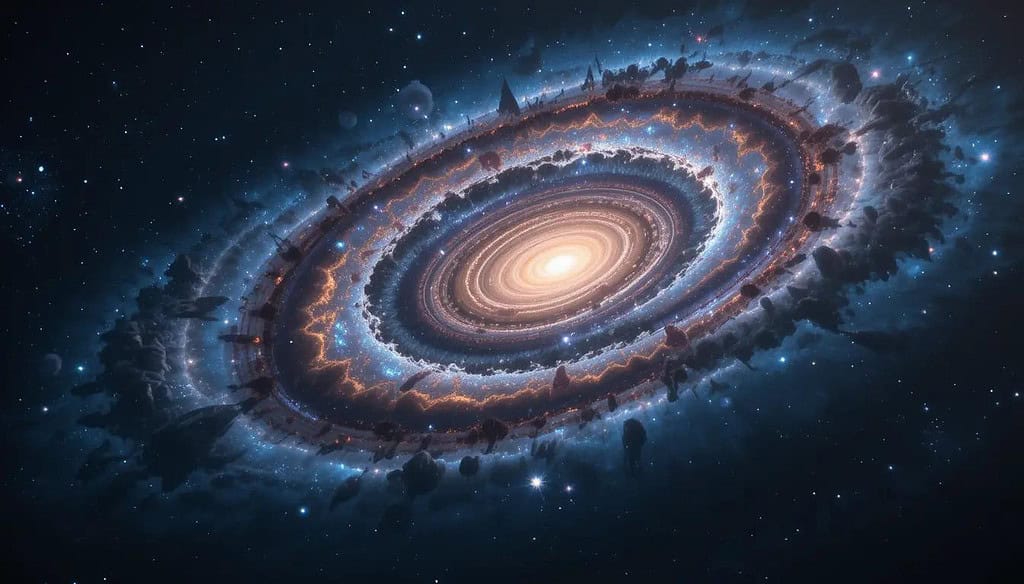
And just like that, our journey through the universe’s most scandalous stories comes to an end. From daring galactic collisions to mysterious dark matter cloaks, it’s clear that galaxies are more than just floating collections of stars. They’re vibrant, dynamic characters in a cosmic drama that’s been unfolding for billions of years.
Think of the Milky Way, our home galaxy, as a star of this show. It’s not just sitting around quietly—it’s actively engaging in galactic politics, making alliances (with satellite galaxies like the Magellanic Clouds) and preparing for an epic showdown with Andromeda. It’s like watching the buildup to a blockbuster movie, except the climax won’t happen for another few billion years.
What makes this gossip even more fascinating is the scale. Galactic events occur over timescales that dwarf human history, yet they’re constantly shaping the universe we live in. Collisions, mergers, and star formations may take millions of years, but their effects are profound, creating stunning sights that inspire awe and curiosity.
And let’s not forget the mysteries that keep us on the edge of our seats. Dark matter, those elusive black holes, and the peculiar shapes of irregular galaxies remind us that the universe still has secrets waiting to be uncovered. It’s like a never-ending season of the most captivating TV show, with plot twists that leave you wanting more.
As we conclude, let’s take a moment to admire the wonder of it all. Galaxies are not merely scientific entities; they are masterpieces, each galaxy with its unique narrative. They serve as a testament to the universe’s vibrant activity, ever-changing and continually astonishing us at every turn.
So next time you gaze at the night sky, remember this: those sparkling points of light are just the tip of the iceberg. Behind them lies a universe filled with drama, beauty, and endless stories. Thanks for joining me on this cosmic gossip adventure—until next time, keep looking up and dreaming big!
Disclaimers: *This article is only for informational purposes.
**Do not make your important decisions solely based on the information provided in this article. Do your own research.
***Information in this article may vary or get updated in the future.
Read More Science and Space Articles
- Dark Energy: 8 Powerful Lessons in Life’s Mysteries
- Blood Orange Adventures: Around the World in 8 Recipes
- Supernova Treasures: 8 Heavenly Metals Shaping Jewelry
- 8 Remarkable Ways Kumquat Shines in Culture and Cuisine
- 8 Amazing Lime Tales: Ancient Groves to Modern Kitchens
- Big Bang: 8 Explosive Steps to Derive The Recipe of Cosmos
- 8 Weird Ways Grapefruit Can Interfere with Medications
- Our Universe: 10 Most Powerful Forces That Shaped Its Fate
- Pomelo in Culture: 8 Heartwarming Ritual Traditions
- 8 Culinary Uses of Oranges That I Highly Recommend
- 8 Astounding Ways Lemons Have Helped Elevate My Mood
- 8 Irresistible Ericaceae Fruits (Heath Family) to Savor and Enjoy
- 8 Incredible and Healthy Cucurbitaceae Fruits to Enjoy
- Top 8 Delicious Anacardiaceae Fruits You Must Try
- 8 Incredible Musaceae Fruits You Need to Try Right Now
- 8 Incredible Vitaceae Fruits: Nature’s Tasty Treasures
- 8 Incredible Rosaceae Fruits You Need to Discover
- Discover 8 Fruit Families That Enrich Our Daily Diets

